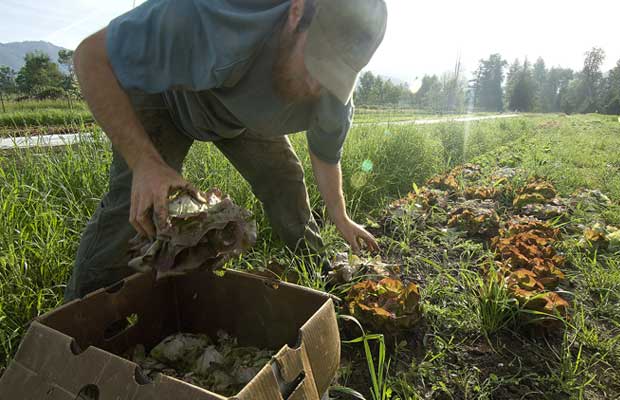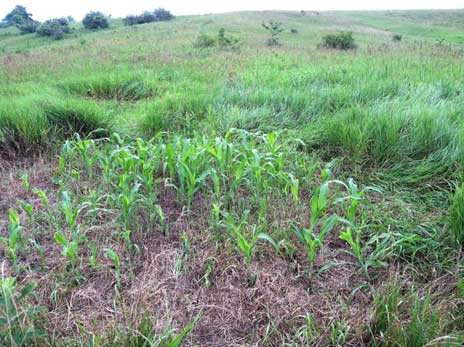Editors Note: The following article has been generously contributed to our community by Bobcat-Prepper.
The phrase “guerrilla gardening” was first used in 1973 in New York City, when Liz Christie and her Green Guerrilla group transformed an empty private lot into a vegetable and flower garden for community use. While not legal it was not challenged, and eventually became part of the NYC Parks Department.
I got the idea for a little guerrilla gardening last year, when I read this Survival Blog post and decided to give it a try in two places – my own backyard, and an abandoned farm not too far from home.
I had never grown field corn before last year, but in the mid-West you see it grown everywhere for cattle feed. In a TEOTWAWKI situation, being able to grow corn for your family would be vital their survival. Why? Because it’s easy to grow, packed with calories, and lasts for several years once harvested.
Here’s how to test the technique in the backyard:
- Select the area of lawn to be converted to corn field. Make sure it is fenced in, or otherwise kept clear of pets and toddlers for a few days.
- Chop holes in rows every 12-18”, plant a couple of corn kernels about 1” deep, and cover with the chopped dirt. Water in the seeds, and the next day spray the whole area with glyphosate (Roundup) prepared as directed on the label. The grass dies before the seeds sprout, and within ten days the corn sprouts should be poking out. Thin the ranks once they get a couple of inches tall.
- When the corn stalks get about a foot tall, plant two climbing bean seeds (like dried pinto beans from the grocery store) a few inches away from the stalk; the bean plants’ roots fix nitrogen in the soil for the corn-stalk, and the corn stalks provide support for the bean plants so they get more sunlight. Beans and corn together provide an excellent nutritional base of carbohydrates and protein. Also, if you can plant another set of bean seeds a couple of weeks before bean harvest time in late July/early August, you may be able to get a second crop harvested by corn harvest time in October/November.
By the end of the growing season, the grass and weeds rotted away, and I had an established garden area. I tried this on my lawn last year (on about 100 sq ft), and I was able to harvest 16 pounds of field corn, and 6 pounds of pinto beans, for a total of about 35,000 calories. Since my family of four needs about 8000 calories a day, I would need about 85 of these plots to cover their needs and have seed corn/beans for the following year. That’s only about 0.2 acres – smaller than most subdivision lots! If you were able to get a second crop of beans, that would provide you with calories to spare, or some extra beans to trade to your neighbors.
This was lawn in the spring of 2014, before converting to corn last year.
Naturally, in a SHTF scenario, I would like to plant more to account for bad weather (like the monsoon season we are having in lieu of summer this year!), infestations, or thievery by two and four-footed critters.
This is where the true guerrilla gardening comes in.
There is an abandoned farm at the end of our subdivision street. The rumor is that it is owned by the subdivision’s developer, but he is in jail on drug charges for a long time, and so any further development is in limbo. Maybe you have seen a similar fallow field or empty lot around your neighborhood that you could control if things go to hell.
Residents occasionally hike through some parts of the farm, so there are trails that wind around the edge of the field, but the tall grass and thorny bushes stop most people from going through it – all the better for me.
Around the first of June, I put a bag of field corn, a hedge trimmer, and a bulb planter into my backpack, and took a little hike. I selected a patch of field that was mostly tall grass for ease of planting, and got to work. Although I was nervous as hell about getting caught, I chopped the grass as low as I could in a 15’ x 15’ square, and threw the grass to the side. Then I got busy with the bulb planter, punching holes in the dense grass root systems, and pushing in the corn seeds. The next day, I packed in a small sprayer loaded with glyphosate, and sprayed the whole area. Within two weeks, I had little rows of corn seedlings. Yay, it worked! When they got about a foot tall, I planted the bean seeds as described.
That’s the good news, but here is the bad news – within a week, I noticed that the grass next the plot was flattened, and the tops of my little corn plants were being nipped. Deer! Those little bastards found the seedlings a tasty change of diet, and are doing their best to commandeer the crop.
So here is what I have learned –
- It would be too expensive to fence my little plot now (about $100), and fencing would draw unwanted attention.
- If I were to guerrilla garden post-TEOTWAWKI, I would do it with whatever surviving neighbors I could trust. We would use fencing acquired after the disaster, and/or take turns patrolling the field until the seedlings matured and were less tasty. This would also provide us an opportunity to hunt deer drawn to the plot, and put some fresh meat on the table. I have also heard that human urine is a natural deer repellent, but I haven’t tried it yet.
- I need to stock up now, to be prepared to implement this plan.
- Fifty pounds of feed corn costs about $5 at a feed supply store, should germinate adequately, and covers about an acre and a half. You could trade or give some to your trusted neighbors that will be part of your guerrilla gardening group.
- 50 pounds of dried will complement the corn, and is good for eating if gardening doesn’t work out.
- A variety of other garden seeds – tomatoes, cabbage, and other foods that can be kept/canned.
- About a gallon of glyphosate and a couple of sprayers.
- A couple of bulb planters, trowels and/or shovels.
- Adequate firearms and ammo for guarding the crop and hunting deer.
While it is a little late in the season to expect to harvest, why not try it anyway soon near you? Better to learn now what works than later!
If you found this article useful, please Vote for The Prepper Journal as a top prepper web site.
Copyright Information This information has been made available by The Prepper Journal. Content on this site (unless the work of a third-party) may be shared freely in digital form, in part or whole, for non-commercial use with a link back to this site crediting the author. All links in articles must remain intact as originally posted in order to be republished. If you would like to be notified of new articles, contests and Prepper news, please sign up for our daily newsletter, follow us on Twitter, or Like Us on Facebook.









